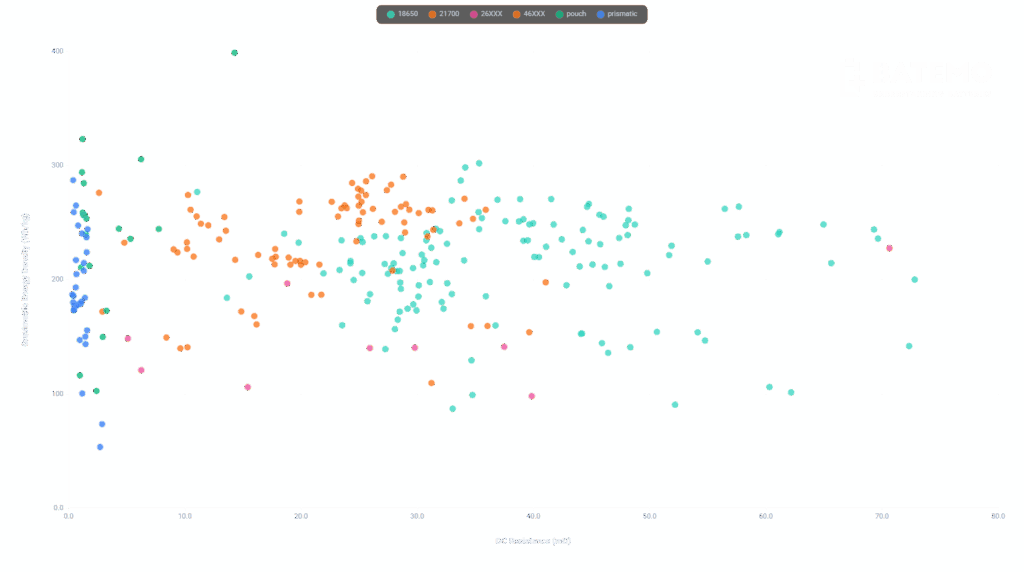• 100% Consistency – no datasheets, no estimates, only high-quality data acquisition
• Instant One-Click Comparisons – find the perfect cell in seconds
• Unlimited Access to all cells for members
リチウムイオンバッテリーセル muRata US18650-VTC4 に関する全ての情報が手に入ります。全運転領域での詳細な測定データ、高精度かつグローバルに有効な物理バッテリーモデル、そして材料や微細構造の詳細を含む分解レポートが含まれています。
| セルの起源 | 自由市場で購入 |
| セルの形式 | 18650 |
| 寸法 | 18.1 x 64.6 mm |
| 重量 | 45.1 g |
| 容量 定義閉じる
公称容量は、利用可能な場合、メーカーのデータシートに基づいています。データシートが利用できない場合、公称容量は推定されます。バテモは、セルを25°Cの周囲温度で100%から放電し、一定の電流でC/10容量を測定しました。0.21A (0.1C) で、2.5Vに達するまで放電しました。熱的境界条件は自然対流です。
|
公称 2.10 Ah C/10 2.13 Ah |
| 電流 定義閉じる
すべての量は、バテモ・バッテリーラボからの測定結果です。
連続電流は、セルを過熱せずに完全に放電できる最大電流です。したがって、セルは25°Cの周囲温度で100%の充電状態(SOC)から定電流で放電され、残りの充電状態が10%になるまで、または下限電圧制限の 2.5V もしくは最大表面温度の90%(72#176;C)に達するまで放電されます。 ピーク電流は、セルが5分間供給できる電流です。したがって、セルは25°Cの周囲温度で100%のSOCから定電流で放電され、5分後に下限電圧制限の 2.5V または最大表面温度の 80°C のいずれかに達するまで放電されます。最大表面温度に達するセルの場合、測定された電流が直接ピーク電流として扱われます。5分後に最大表面温度に達しないが下限電圧制限に先に達するセルの場合、測定された電流は補正係数で調整され、これにより5分以内にセルを最大表面温度まで加熱するであろう電流が推定されます。 熱的境界条件は自然対流です。これらの運転条件は、セルメーカーの仕様を超えている可能性があります。 |
連続 14.7 A ピーク 22.0 A |
| エネルギー 定義閉じる
バテモは、セルを25°Cの周囲温度で100%から一定電流の 0.21A (0.1C) で放電し、2.5V に達するまでのC/10エネルギーを測定しました。熱的境界条件は自然対流です。
|
C/10 7.88 Wh |
| 電力 定義閉じる
すべての量は、バテモ・バッテリーラボからの測定結果です。
連続電力は、セルを過熱することなく完全に放電できる最大の電力です。したがって、セルは25°Cの周囲温度で100%の充電状態(SOC)から一定電流で放電され、残りの充電状態が10%になるまで、または下限電圧制限の 2.5V または最大表面温度の90%(72°C)に達するまで放電されます。 ピーク電力は、セルが5分間供給できる電力です。したがって、セルは25°Cの周囲温度で100%のSOCから一定電流で放電され、5分後に下限電圧制限の 2.5V または最大表面温度の 80°C のいずれかに達するまで放電されます。最大温度制限に達するセルの場合、測定された電力が直接ピーク電力として扱われます。最大表面温度に5分後に達しないが、先に下限電圧制限に達するセルの場合、測定された電力は補正係数で調整され、これにより5分以内にセルを最大表面温度まで加熱するであろう電力が推定されます。 熱的境界条件は自然対流です。これらの運転条件は、セルメーカーの仕様を超えている可能性があります。 |
連続 49.2 W ピーク 71.9 W |
| エネルギー密度 定義閉じる
エネルギー密度は、C/10エネルギー、セルの重量、およびセルの体積から算出されます。
|
重量エネルギー密度 175 Wh/kg 体積エネルギー密度 474 Wh/l |
| 電力密度 定義閉じる
電力密度は、ピーク電力、セルの重量、およびセルの体積から算出されます。
|
重量電力密度 1.60 kW/kg 体積電力密度 4.33 kW/l |
リチウムイオンバッテリーセル muRata US18650-VTC4 のバテモ・セルモデルは、世界的に有効な高精度の物理セルモデルです。デジタルツインとして、シミュレーションに基づいて意思決定を行うことで、研究、開発、バッテリー分析にシームレスに統合できます。バテモ・セルモデルの特徴と機能については、詳細をご覧ください。
| バテモセルモデル バージョン | 1.303 |
| リリース日 | 2020年09月01日 |
バテモ、以下の範囲でバッテリーシミュレーションと測定データを比較することにより、バテモセルモデルの精度と有効性を示しています。検証は広範囲にわたり、実験的な特性評価はセルの全運用領域をカバーしています。低温および高温で、最大電流まで、および全充電状態範囲内で。
| 充電状態範囲 | 0 … 100% |
| 電流範囲 定義閉じる 電流範囲は、バテモ・バッテリーラボで使用される電流限界です。セルの安全な動作範囲の正確な定義については、 muRata US18650-VTC4 データシートを参照してください。 |
-32 A 放電 … 6 A 充電 (-15.0C … 3.0C) |
| 電圧範囲 定義閉じる 電圧範囲は、バテモ・バッテリーラボで使用される電圧限界です。セルの安全な動作電圧範囲の正確な定義については、 muRata US18650-VTC4 データシートを参照してください。 |
2.5 … 4.2 V |
| 温度範囲 定義閉じる 温度範囲は、バテモ・バッテリーラボで使用される温度限界です。セルの安全な動作温度範囲の正確な定義については、 muRata US18650-VTC4 データシートを参照してください。 |
-25 … 80 °C |
さらにバテモ・セルモデルの検証は、非常に透明性をもって行われています。バテモ・セルデータには、生の測定データとシミュレーションデータが含まれています。すべての実験では、電圧、温度、電力、エネルギーの精度が計算されます。これにより、バテモ・セルモデルの有効性を簡単に評価および分析することができます。グラフは、セルの性能を評価するために、セル「muRata US18650-VTC4」の特性データの選択を示しています。バテモ・セルモデルが完成すると、予測結果が含まれます。
実験の定義を表示閉じる
平均精度は、バテモセルモデルの精度の概要を示します。したがって、測定結果とシミュレーション結果の差の二乗平均平方根は、電圧、温度、エネルギー、および電力について導き出されます。相対値は、それぞれの絶対値に対する精度を示します。
| 平均電圧精度 | 0.026 V | 0.9 % |
| 平均温度精度 | 0.5 K | 0.4 % |
| 平均電力精度 | 0.17 W | 0.8 % |
| 平均エネルギー精度 | 0.050 Wh | 1.3 % |
バテモセルモデルは、セルのすべての側面を正確に説明します。これは、バッテリーシステムの開発に最適なツールです。
バテモは、バッテリーセル muRata US18650-VTC4 の広範な実験的特性評価を提供します。 データには、セルの全運用エリアにおける測定結果が含まれています。以下の説明とグラフは、利用可能な測定結果を説明し、示しています。バテモ・セルビューアーは、データの簡単で迅速な分析、評価、比較を可能にします。詳しくは詳細をご覧ください。
セルは、さまざまな環境温度で異なる定電流で100% SOCから放電されるか、0% SOCから充電されます。熱境界条件は自由対流です。測定は、電圧が 2.5Vまたは 4.2Vまたは表面温度が 80°Cに達すると停止します。 グラフは、どの環境温度と充電および放電の定電流で測定が利用可能かを示しています。
セルは、さまざまな環境温度で無負荷フェーズに続いて電流パルスで100% SOCから放電されるか、0% SOCから充電されます。熱境界条件は自由対流です。 測定は、電圧が 2.5Vまたは 4.2Vまたは表面温度が 80°Cに達すると停止します。 グラフは、どの環境温度とパルス電流で測定が利用可能かを示しています。
| 周囲 温度 |
利用可能な プロファイル |
|---|---|
| 0 °C |  |
| 25 °C |  |
| 40 °C |  |
セルは、さまざまな環境温度で100% SOCから典型的なパワープロファイルを提供します。熱境界条件は自由対流です。測定は、電圧が 2.5Vまたは表面温度が 80°Cに達すると停止します。テーブルは、どの環境温度でプロファイルが利用可能かを要約しています。
バテモは、電池セル muRata US18650-VTC4 の詳細なレポートを提供します。レポートには、セルに関する重要な全ての情報が含まれています。この情報は、セルの評価や比較を進めるのに非常に有用です。これは、バッテリーシステム設計に関する決定のための重要な基盤です。詳細をご覧ください。
| 性能概要 |  |
| セルの外装 |  |
| セルの内部 |  |
| 安全機能 |  |
| 電極の微細構造と材料 |  |

Get in touch with an expert and receive a customized quotation for access to Batemo Insights.



Batemo はバッテリーの再販業者ではありません。あなたは Reliance からセル muRata US18650-VTC4 を購入することができます。お見積もりをご希望の方は、下記のフォームにご記入ください。

Batemo はバッテリーの再販業者ではありません。あなたは BAK Battery からセル muRata US18650-VTC4 を購入することができます。お見積もりをご希望の方は、下記のフォームにご記入ください。

Batemo はバッテリーの再販業者ではありません。あなたは TENPOWER からセル muRata US18650-VTC4 を購入することができます。お見積もりをご希望の方は、下記のフォームにご記入ください。

Batemo はバッテリーの再販業者ではありません。あなたは Lishen Battery (SuZhou) Co., Ltd からセル muRata US18650-VTC4 を購入することができます。お見積もりをご希望の方は、下記のフォームにご記入ください。

Batemo はバッテリーの再販業者ではありません。あなたは FEB からセル muRata US18650-VTC4 を購入することができます。お見積もりをご希望の方は、下記のフォームにご記入ください。

Batemo はバッテリーの再販業者ではありません。あなたは V4Smart からセル muRata US18650-VTC4 を購入することができます。お見積もりをご希望の方は、下記のフォームにご記入ください。

Batemo はバッテリーの再販業者ではありません。あなたは Farasis からセル muRata US18650-VTC4 を購入することができます。お見積もりをご希望の方は、下記のフォームにご記入ください。
Batemo はバッテリーの再販業者ではありません。あなたは muRata からセル muRata US18650-VTC4 を購入することができます。お見積もりをご希望の方は、下記のフォームにご記入ください。
Batemo はバッテリーの再販業者ではありません。あなたは DMEGC からセル muRata US18650-VTC4 を購入することができます。お見積もりをご希望の方は、下記のフォームにご記入ください。

Batemo はバッテリーの再販業者ではありません。あなたは Aspilsan からセル muRata US18650-VTC4 を購入することができます。お見積もりをご希望の方は、下記のフォームにご記入ください。

Batemo はバッテリーの再販業者ではありません。あなたは Molicel からセル muRata US18650-VTC4 を購入することができます。お見積もりをご希望の方は、下記のフォームにご記入ください。

Batemo はバッテリーの再販業者ではありません。あなたは BMZ Germany GmbH からセル muRata US18650-VTC4 を購入することができます。お見積もりをご希望の方は、下記のフォームにご記入ください。

バテモセルモデルを手に入れる
専門家に連絡して muRata US18650-VTC4 セルの最も正確なバッテリーモデルの見積もりを取得してください。

バテモ細胞レポート
専門家に連絡して muRata US18650-VTC4 セルの詳細なセルレポートの見積もりを取得してください。

専門家に連絡して muRata US18650-VTC4 セルの完全な実験的特性評価の見積もりを取得してください。
You are currently viewing a placeholder content from Vimeo. To access the actual content, click the button below. Please note that doing so will share data with third-party providers.
More InformationYou are currently viewing a placeholder content from YouTube. To access the actual content, click the button below. Please note that doing so will share data with third-party providers.
More InformationYou need to load content from reCAPTCHA to submit the form. Please note that doing so will share data with third-party providers.
More InformationYou are currently viewing a placeholder content from Facebook. To access the actual content, click the button below. Please note that doing so will share data with third-party providers.
More Information